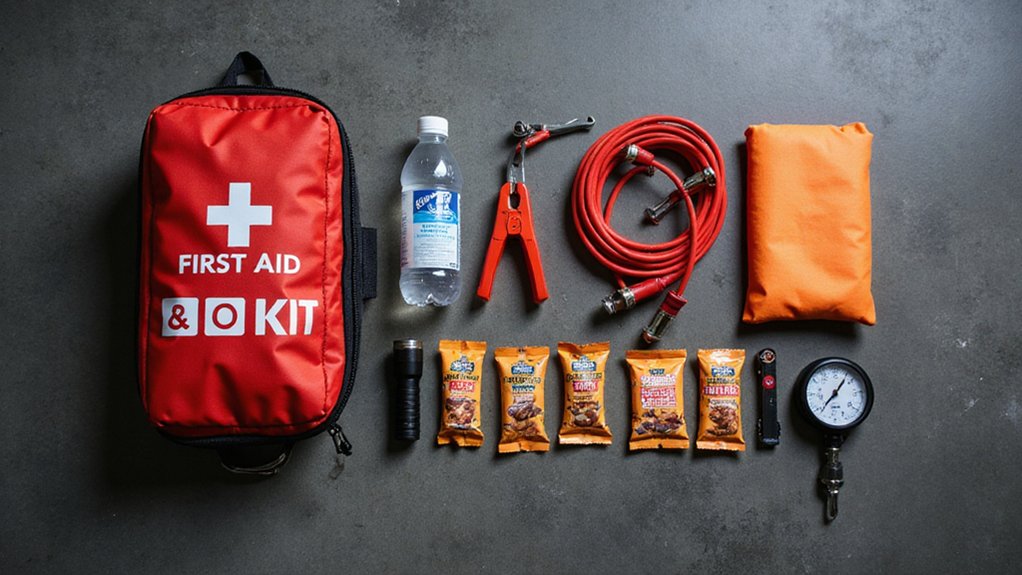As a driver, you'll want to keep an emergency kit with critical items like a first aid kit, vehicle repair tools, communication devices, non-perishable food, and protective gear. Your kit should include bandages, jumper cables, a GPS, bottled water, and a flashlight with extra batteries. These essentials can help you stay safe and prepared during unexpected roadside challenges, turning potential emergencies into manageable situations.
First Aid Kit and Medical Supplies
Whether you're planning a long road trip or just commuting to work, a thorough first aid kit can make all the difference in an emergency.
You'll want to include essentials like adhesive bandages, sterile gauze, antiseptic wipes, pain relievers, and tweezers. Don't forget personal medications and any specific health supplies you might need.
Consider adding emergency blankets, instant cold packs, and medical gloves for unexpected situations. A well-stocked first aid kit isn't just smart—it's a lifeline that can help you stay calm and prepared when unexpected health challenges arise on the road.
If you encounter a roadside emergency, having a first aid kit is crucial, especially when roadside assistance services might take time to arrive.
Vehicle Repair and Maintenance Tools
Since unexpected car troubles can strike at any moment, smart drivers always keep a thorough set of vehicle repair and maintenance tools in their trunk. You'll want basic items like a tire jack, lug wrench, jumper cables, and a compact tool kit. These essentials can help you handle minor roadside emergencies without calling for expensive professional help. In case of more serious issues, having roadside assistance contact information for local towing services can provide additional peace of mind. Consider adding wheel wedges, a flashlight with extra batteries, work gloves, and duct tape to your collection. By preparing ahead, you'll feel more confident and self-reliant when challenges arise, converting potential stress into manageable situations.
Communication and Navigation Equipment
Most modern drivers recognize that reliable communication and essential tools are indispensable for safe and stress-free travel. You'll want to invest in a smartphone with a portable charger, ensuring you can call for help or access maps during emergencies.
Additionally, consider a dedicated GPS device as a backup directional system. A two-way radio can be priceless in areas with poor cell coverage, providing an alternative communication method. Don't forget a physical road atlas as your final navigation safeguard, which doesn't rely on battery power or signal strength.
Emergency Food and Water
Every smart driver knows that carrying emergency food and water can be a lifesaver during unexpected roadside situations.
Your survival kit should include non-perishable, high-energy foods like energy bars, dried nuts, and canned goods that won't spoil quickly. Pack at least one gallon of water per person and rotate your supplies periodically to guarantee freshness.
Choose compact, lightweight items that can withstand temperature variations. Consider individual needs like dietary restrictions or medical conditions.
Protective Clothing and Survival Gear
When unexpected road emergencies strike, having the right protective clothing and survival gear can make all the difference between comfort and potential danger. You'll want a waterproof jacket, sturdy gloves, and extra layers to protect against harsh weather conditions.
Pack a compact emergency blanket that'll keep you warm during unexpected roadside situations. Include a reliable flashlight with extra batteries, a multi-tool with various functions, and a pair of sturdy boots in case you need to change a tire or walk for help. Your survival depends on being prepared.
Emergency Signaling and Lighting Devices
Because roadside emergencies can happen anytime, having reliable emergency signaling and lighting devices could literally save your life. Reflective warning triangles, bright LED flares, and powerful flashlights help you remain visible and safe during unexpected breakdowns.
You'll want battery-powered or rechargeable devices that can signal your location to passing drivers and emergency responders. Consider portable options that are compact, durable, and easy to store in your vehicle.
Magnetic-base emergency lights and battery-powered strobes provide excellent roadside visibility, ensuring other drivers can see you clearly during low-light conditions or nighttime emergencies.
Roadside Safety and Assistance Items
Several essential roadside safety and assistance items can convert a potential disaster into a manageable situation. You'll want a sturdy jack, wheel wedges, and a lug wrench to handle unexpected tire issues confidently.
A well-stocked first-aid kit can help you address minor injuries quickly and safely. Jumper cables are imperative for battery emergencies, while a basic tool kit can help you make temporary repairs.
Don't forget work gloves to protect your hands and a reflective safety vest to increase your visibility if you're working near traffic. Being prepared isn't just smart—it's indispensable.
Frequently Asked Questions
How Often Should I Replace Items in My Emergency Kit?
You'll want to check and refresh your emergency kit annually. Replace expired medications, rotate food and water, and inspect batteries and first aid supplies to ascertain everything's in top condition when you need it.
Can I Store Emergency Supplies in an Extremely Hot Car?
You'll want to avoid storing emergency supplies in a hot car, as extreme temperatures can degrade items like first aid kits, medications, and food, potentially rendering them ineffective when you need them most.
Are There Any Specific Emergency Items for Different Climate Zones?
You'll need climate-specific emergency supplies: desert kits with extra water and sunscreen, arctic zones require thermal blankets and hand warmers, and humid regions demand moisture-resistant packaging for your gear.
What's the Most Compact Way to Organize Emergency Kit Supplies?
You'll want a slim, multi-compartment bag that nestles compact items like first-aid supplies, flashlight, and multi-tool in vertical, easy-access layers to maximize space and minimize bulk.
How Do I Maintain Emergency Kit Items on a Budget?
You'll save money by buying multi-purpose items from dollar stores, checking expiration dates regularly, and replacing supplies gradually. Thrift and preparation can coexist when you're smart about your emergency kit.



